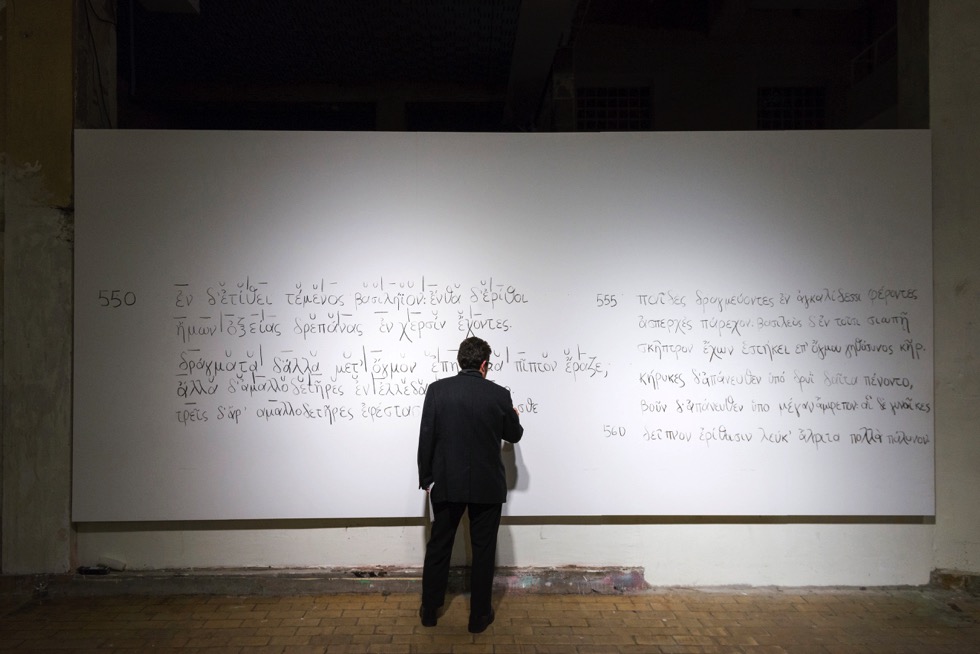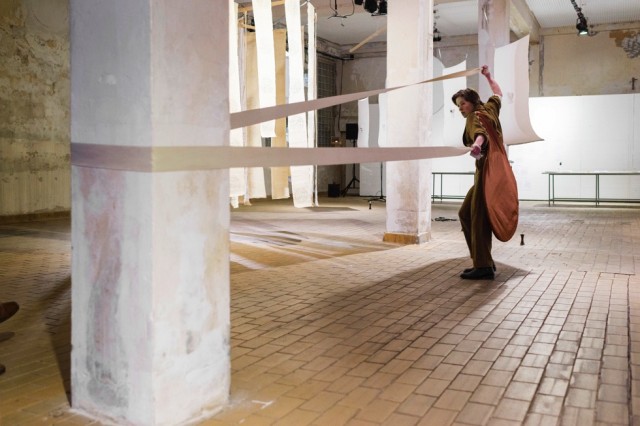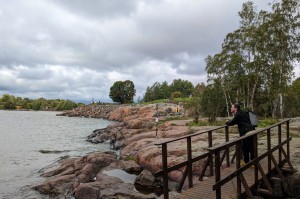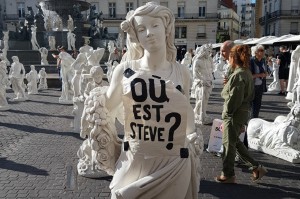Field Trip: “Doing art politically and not making political art” — Kringsatt Av Fiender, Bergen, Norway

Bob Dickinson joins international art group Alt Gar Bra for an evening of live work, discussion and debate on contemporary art’s role in regards to war, climate change, the market state and globalism…
It isn’t easy to explore convincingly the potential for contemporary art to be political. Many very well-known contemporary artists claim they are doing this in their work, but when that work is encountered it is often difficult to disentangle the artist’s career-path from political posturing or plain wishful thinking.
The point of the exercise should be to encourage audiences to think, to question, and to debate. And despite the fact that galleries and museums are nowadays keen to offer the chance for audiences to listen and to some extent talk back to artists, curators, critics, or art historians, it is rare for audiences and artists to be linked together in the unfolding of an artistic project which has politics embedded within it.
In the work of the art group Alt Gar Bra, which includes artists from Bergen, Paris and London, a new project is under way, which has made itself consciously aware of these problems, as well as retaining an intelligent awareness of the current crisis-ridden state of politics in Europe. It is called Kringsatt Av Fiender, or Besieged by Enemies, and it was marked by an evening of live work, discussion and debate in April, at Bergen Kjott, Bergen, Norway: a large, ex-industrial building on the city’s waterfront. It is important to mention also that the project is linked to an already-established series of events that the group as been running in Bergen, and to the launch of a book, Victor Charlie Report, responding not only to the 2015 attacks in Paris but to reactions to such horrors in the press and media.
Furthermore, it must be mentioned that this writer is also involved in Alt Gar Bra, and took part in Kringsatt Av Fiender, as well as the dissemination and unfolding of other linked events in the ongoing Bergen-based series, Tout Va Bien, and that therefore this article can itself be seen as part of that wider dissemination and unfolding.
So, when Kringsatt Av Fiender was launched, what did audiences encounter, exactly? Did they – and can they possibly – experience what Alt Gar Bra (quoting the words of Thomas Hirschhorn, an artist the group admire) calls “doing art politically and not making political art”?

Perhaps it is best to begin addressing those two questions by describing the event chronologically. On entering the building, you first noticed a table covered with books – copies of Victor Charlie Report – and prints. Looking closely, it was noticeable that the way these publications have been reproduced is not conventional; they have a kind of hand-made quality about them. The pages of the book, for instance, were printed on old Gestetner machines, deliberately revisiting the hand-cranked, stencil-based technology used by many countercultural publications during the 1960s. Then, after climbing the staircase to the first floor, you encountered a space that was filled with installations – one, for instance, consisting of a collection of pillows somehow made out of recent newspapers, filled with air (placing today’s mass media, at the opposite end of the scale to Gestetner-printing, with its intimate and handmade qualities) There was a wall lined with paintings based on the classical image of a pair of fighting gamecocks. And from the ceiling were suspended circular screens for viewing a Skype interview.
At the far end of the space, London-based artist Oscar MacFall was performing the slow and gentle process behind gelatin printing – another neglected technique once used in schools but also by artists like Edvard Munch. The image he was reproducing – finished examples of which were shown on the wall behind him – was a verbalised rendition of the Shield of Achilles described in the poetry of Homer: a key image and idea behind the group’s current project, more details of which emerged as the event went on. Nearby, another artist, Opie Boero Imwinkelried began writing a series of quotations from Homer in ancient Greek lettering on another wall, eventually performing a kind of dance, in the form of a series of steps and sidesteps linked to the rhythm of the text.
Agnes Nedregard was born and brought up in Bergen but now lives in Paris. Her performance started with a young girl singing the song that had given the show its title. Kringstatt Av Fiender is a political ballad, from 1936, using as lyrics the poem by the Bergen-born novelist, journalist, dramatist and left-wing campaigner, Nordahl Grieg. Nedregard alternated between struggling with a disc-shaped, shield-like appendage she was wearing – or bearing – as part of her costume, with sequences of joyful skipping. At one point she was bound up, restricted by bands wrapped around her arms and legs. And then, once freed, she laboured to explore the limits of what looked like a giant elastic band, which she wrestled and pulled and tried to defeat and control. It was exhausting and exhilarating to watch. And at the end, Agnes sang her version of the same song, but very differently to the little girl we saw at the beginning: Agnes sounding fractured, edgy, and angry. That anger, in the context of this project, exemplifies a bringing-together, through artistic embodiment, of the personal and political.
Preceding these performances was an interview (projected on to the circular screens) with the Texas-born historian, academic, and political adviser, Philip Bobbitt, speaking live from the United States. His book The Shield of Achilles: Peace and the Course of History (2002), describes the changing characteristics of the governmental state in relation to evolving styles of warfare, peace conferences and treaties, and the eventual emergence in the contemporary world of the “market state”. Political leaders including Tony Blair have been eager to endorse Bobbitt’s ideas. Importantly, Bobbitt’s book links the sweep of history with a work of art – the design on the shield described by Homer – thus placing the contemporary artist in an unenviable position that raises vital questions about art’s role in today’s world which is so fractured by warfare and violence.
And yet, according to Bobbitt himself, things have not quite worked out in the way he expected since his book was published 14 years ago. Bobbitt admitted he was “disappointed” in recent history: Anglo-American interventionist wars in Iraq and Libya, the civil war in Syria, and long-term lack of progress on climate change, were all mentioned by him. The “true” market state has yet to emerge.
Kringsatt Av Fiender therefore is trying to reposition the role of the artist at the heart of a complex web of contemporary concerns, which are as much ethical as they are political. Some of these concerns were explored in a public discussion (in the same exhibition space) the day after the performance-led opening. Featuring Alt Gar Bra artists, Agnes Nedregard, Opie Boero Imwinkelried, Oscar MacFall, myself, plus a guest, Dimitiri Vilensky, founder member of the Russian artist-collective Chto Delat?, the discussion ranged across subjects including artistic strategy, the role of the audience, Russia’s relationship to the so called “market state”, art and neo-liberal economics, and contemporary art and globalism. It was a fascinating afternoon of ideas and thoughts with which the audience were eager to get involved and raise questions.
And what is most important is that the discussion has only just begun. Alt Gar Bra and the artists and thinkers with whom they are collaborating will continue to develop relationships, and through these, further words and further work will be produced. And included within these will be an appearance by Domenico Losardo, the Italian historian whose views on war and capitalism are very much the opposite of Bobbitt’s.
Bob Dickinson
Bob saw Alt Gar Bra’s show, Kringsatt Av Fiender, between 1-2 April 2016 in Bergen, Norway
See all the upcoming Alt Gar Bra events here, including Tout Va Bien talks series:
10-12/06/2016, Miss Read: The Berlin Art Book Fair 2016, Akademie der Künste, Berlin, Germany
05/07/2016, Tout Va Bien Series: guest Chantal Mouffe, Bergen Kunsthall/Landmark, Bergen, Norway
22/09/2016, Tout Va Bien Series: guest Le Peuple Qui Manque, Bergen Kunsthall/Landmark, Bergen, Norway
20/10/2016, Tout Va Bien Series: guest Domenico Losurdo, Bergen Kunsthall/Landmark, Bergen, Norway
23/11/2016, The Performance Studio, London, UK
12/2016, Chto delat’s School of Engaged Art, St. Petersburg, Russia





